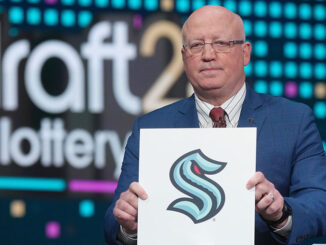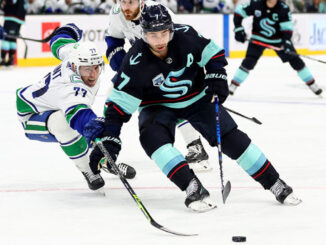
Last week, I highlighted three of the Seattle Kraken’s biggest roster needs heading into the final few weeks before the 2023 NHL trade deadline. This week, I will offer three names that could address those particular holes in the lineup and which will likely be available at the upcoming deadline.
The Kraken languished at the bottom of the league standings last season, incentivizing the organization to use the deadline as an opportunity to accrue draft picks and bolster their budding farm system.
This season, the Kraken will be on the other side of the sellers-buyers divide. At the time of this writing, their 27-14-5 record and 59 points are good enough for second place in the Pacific Division (but first by points percentage). Seattle remains slightly off the pace of the Western Conference-leading Dallas Stars (63 points), but not by much.
The Kraken are projected to have over $5 million in cap space on deadline day and own their first- and second-round picks for the next three seasons. Previous deals have also garnered a pair of second-rounders from the Toronto Maple Leafs and the Winnipeg Jets, so the Kraken are well-positioned to be active on March 3rd.
With that context in mind, here are three players (with three honorable mentions) that the Kraken should target at the deadline in anticipation of a deep playoff run.
Timo Meier, San Jose Sharks
If the San Jose Sharks play their cards right, they could be the NHL’s leading power broker at the 2023 trade deadline. While netminder James Reimer, center Nick Bonino, or a rejuvenated Erik Karlsson could garner some attention, winger Timo Meier should be the topic of most trade discussions.
The 26-year-old Meier carries a $6 million cap hit this season and is among the Sharks’ scoring leaders in goals (first with 27) and points (second with 47). The Kraken are having little trouble finishing their chances this season (they lead the NHL in team shooting percentage), but Meier offers a different dimension to their forward group.
The Swiss forward is a relentless shot- and entry-generating machine at 5-on-5. He ranks second among qualified forwards in shots and scoring chances per 60 and third in expected goals per 60 from 2020-23.
Related: Is The Seattle Kraken’s Offensive Success In 2022-2023 For Real?
Most appealing to the Kraken is that he does most of his damage off the rush, where he’s created the second-highest rate of shots in transition behind only Nikita Kucherov. Meier grades out as one of the best forwards in terms of completing zone entries and turns them into actual chances at an equally high rate relative to his peers.
Collectively, Seattle hovers near the middle of rush offense, so inserting a scoring winger with some zip could diversify a somewhat homogenous forward group.
The most pressing concern with Meier is that, as a restricted free agent (RFA), his qualifying offer for next season would come in at $10 million. Not only would the Kraken find it challenging to fit that large of a salary in next season, but he could refuse to sign and become an unrestricted free agent, force a trade, or walk away as an unrestricted free agent (UFA) after next season.
Unless a long-term extension is hammered out ahead of time, the uncertainty surrounding Meier could scare teams off and lead to a depressed acquisition cost. Meier is one of the NHL’s premier shooting threats, so the risk is worth the reward.
Honorable Mention: Bo Horvat, Vancouver Canucks
Karel Vejmelka, Arizona Coyotes
While the Kraken are benefitting from an extraordinarily hot run of finishing, they’ve seen the opposite from their goaltenders. Both Martin Jones (50th) and Philipp Grubauer (55th) sit in the bottom 20 of qualified goalies (minimum ten games played) in save percentage (SV%) this season despite earning a collective $7.9 million against the cap.
Teams can run extreme percentages at both ends of the ice, but in the long term, regression wins out. The Kraken must find a way to improve their situation in the crease, preferably before their shooters come down from outer space.
One of the best and most cost-effective options on the market is Arizona Coyotes netminder Karel Vejmelka. The 26-year-old is under contract at $2.75 million per year for two more seasons after this one, but the Coyotes don’t figure to be competitive within that time. Further, Vejmelka is doing more harm than good with his play when it comes to securing the best possible spot in the Connor Bedard sweepstakes.
Related: 4 Seattle Kraken Predictions For The Second Half Of The 2022-2023 Season
Vejmelka’s .904 SV% only ranks 35th among qualified goaltenders this season, but he’s saved 14.2 goals above expected (GSAx), the seventh-highest total in the NHL. He’s standing tall despite the Coyotes’ porous defense in front of him, and it follows that he could be even better behind a team defense ranking in the top third by most advanced metrics.
Injured backup Chris Driedger is still on the books through next season ($3.5 million), so inserting another netminder into the mix could create complications. Jones is on an expiring contract, but Grubauer’s big-ticket contract (owed $5.9 million through 2026-27) could prove near impossible to move without significant salary retention or the addition of sweeteners.
Still, it’s arguably the Kraken’s most significant flaw, and failing to address it in some capacity could prove fatal come the postseason if the offense dries up.
Honorable Mention: Anton Forsberg, Ottawa Senators
Shayne Gostisbehere, Arizona Coyotes
The appeal in adding defenseman Shayne Gostisbehere is clear: he’s an offensively inclined blueliner who thrives at kickstarting breakouts. The veteran blueliner enjoyed his most productive NHL seasons under Dave Hakstol with the Philadelphia Flyers, although the pair had a strained relationship.
The Coyotes’ star defender Jakob Chychrun – and most attractive trade bait – missed the start of the season, but Gostisbehere picked up the slack. He’s tallied nine goals and 29 points in 47 games, a pace that matches his 51 points in 82 games for the Coyotes last season.
Gostisbehere moves the puck out of the zone at an above-average rate and completes incisive passes, but he’s a bit of a liability when it comes to defending his own blueline. If he’s going to thrive in his new locale, it’d be best to shelter him with favorable zone deployment and with a partner who can cover his defensive missteps.
Speaking of such a player, Carson Soucy ($2.75 million) ranks fifth among the team’s defensemen in ATOI and, despite his solid defensive resumé, could be dealt for the required cap space. The Kraken could choose to keep him, and pairing Soucy with Gostisbehere would give Hakstol three balanced pairs to roll out in the playoffs.
Defense isn’t the Kraken’s biggest need, and cap space is at a premium, so a move may not materialize, with a blueline addition looking more like a luxury at this point. Vince Dunn owns the role of the defenseman on the top powerplay, so Gostisbehere would likely be relegated to the secondary unit.
Honorable Mention: Matt Roy, Los Angeles Kings
Kraken Have Flexibility Heading into Trade Deadline
The Kraken are carrying a decent amount of cap space and a bouquet of intriguing assets with which to tempt would-be sellers at the deadline. The balance of power currently resides in the Eastern Conference, with the NHL’s top four teams by PTS% hailing from the East.
Even so, the Kraken should have the chance to capitalize on a tight Western Conference field with preseason favorites like the Colorado Avalanche and Vegas Golden Knights struggling with injury concerns.
The scene is set for Seattle to replicate the playoff magic flashed by their expansion cousins in the Golden Knights. It’s up to them if they wish to step up to the occasion.
Buckle up, everyone – NHL trade season is in full swing.
Data courtesy of AllThreeZones, Hockey Reference, Natural Stat Trick, and the NHL. Statistics are accurate before games being played on January 23rd.




